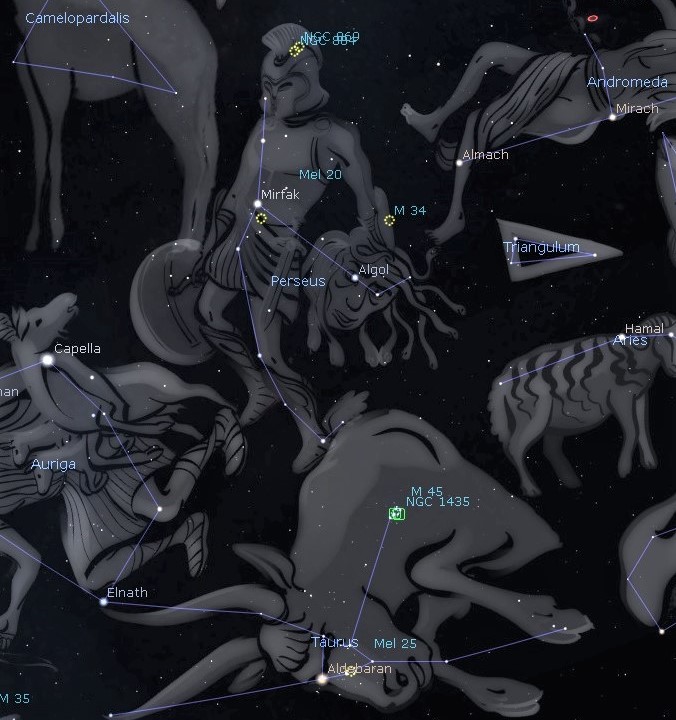This Week’s Sky at a Glance, 2020 November 28 – December 5
~by Curt Nason
I like to observe the sky at least once every day that I can, even if it is just for a few minutes. At night, if I don’t feel like taking out a telescope, I grab binoculars to tour the brighter star clusters. The winter constellations, which are prominent now in late evening, are home to many star clusters within easy reach of binoculars.
I usually start with the best open cluster, the Pleiades (M45), in the shoulder of Taurus the Bull, and focus the binos on its stars. The large V-shaped Hyades cluster, catalogued as Melotte 25, is nearby forming the face of the bull. It is anchored by orange Aldebaran at one corner, but that star is not really part of the cluster because it is less than half the distance to the others. The brightest star in nearby Perseus, Mirfak, is part of a group of stars called Melotte 20 that resembles a miniature version of the constellation Draco in binoculars. Perseus also holds the star cluster M34, which appears as a fuzzy patch in binos due to its distance. Between Perseus and Cassiopeia is a scenic close pair of clusters, NGC 869 and NGC 884, aptly called the Double Cluster.
This Week in the Solar System
Saturday’s sunrise in Moncton is at 7:37 am and sunset will occur at 4:36 pm, giving 8 hours, 59 minutes of daylight (7:40 am and 4:44 pm in Saint John). Next Saturday the Sun will rise at 7:45 am and set at 4:33 pm, giving 8 hours, 48 minutes of daylight (7:48 am and 4:41 pm in Saint John).
The Moon is full on Monday morning, when keen-eyed observers might catch the subtle gray shading of a penumbral eclipse as the Moon passes just below Earth’s shadow. The best time to observe it is between 5:30 and 6 am. Jupiter continues its approach to Saturn, setting at 8 pm midweek followed by the ringed planet about 10 minutes later. Around that time Mars is near its highest position in the south, where it offers its best views. Mercury rises an hour before sunrise this weekend but that decreases to 40 minutes by next weekend. Venus crosses the constellation border into Libra on Saturday and next weekend it passes between the celestial Pillars of Hercules. Comet C/2020 S3 Erasmus might be visible with binoculars between 6 and 6:30 am, about a fist-width to the right of Venus and a tad lower this weekend. Over the week it moves a little closer to Venus and lower. The International Space Station is making bright early evening passes all week. Check the Heavens Above website for times and locations, and also for locations of Comet Erasmus. Be aware that the comet maps are north up and will need to be tilted to the left for proper orientation in the eastern sky.
With astronomy meetings and outreach activities on hold, you can watch the local Sunday Night Astronomy Show at 8 pm and view archived shows.
Questions? Contact Curt Nason.

